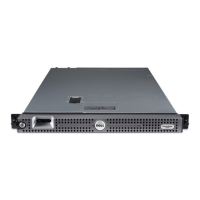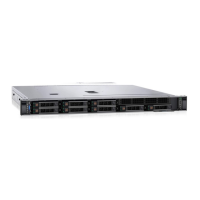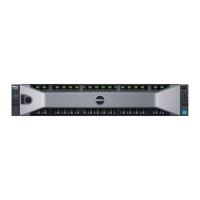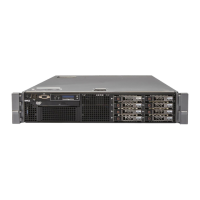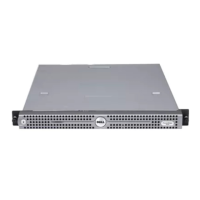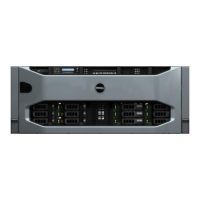Item Indicator, Button, or
Connector
Icon Description
NOTE: On ACPI-compliant operating systems, turning
o the system by pressing the power button causes the
system to perform a graceful shutdown before power to
the system is turned o.
2 NMI button
Enables you to troubleshoot software and device driver errors
when running certain operating systems. This button can be
pressed by using the end of a paper clip.
Use this button only if directed to do so by qualied support
personnel or by the operating system's documentation.
3 System identication button Enables you to locate a particular system within a rack. The
identication buttons are on the front and back panels. When
one of these buttons is pressed, the LCD panel on the front and
the system status indicator on the back ash until one of the
buttons is pressed again.
Press the system identication button to turn the system ID on
or o.
If the system stops responding during POST, press and hold the
system ID button for more than ve seconds to enter BIOS
progress mode.
To reset iDRAC (if not disabled in F2 iDRAC setup), press and
hold the button for more than 15 seconds.
4 Video connector Enables you to connect a display to the system.
5 Diagnostic indicators Glows to display error status. For more information, see
Diagnostic indicators on the front panel.
6 USB connectors Enable you to connect USB devices to the system. The ports
are USB 2.0-compliant.
7 Information tag Contains system information such as service tag, NIC, MAC
address for your reference. The information tag is a slide-out
label panel.
8 Hard drive slots Enables you to install up to four 3.5-inch cabled hard drives.
9 Optical drive or solid state drive
(SSDs) slot
Enables you to install one optional SATA DVD-ROM drive or
DVD+/-RW drive, or two optional 1.8-inch SSDs
LCD panel features
The system's LCD panel provides system information and status and error messages to indicate if the system is operating correctly
or if the system needs attention. For more information about the error messages, see the Dell Event and Error Messages Reference
Guide at Dell.com/openmanagemanuals > OpenManage software.
• The LCD backlight turns blue during normal operating conditions and turns amber to indicate an error condition.
• The LCD backlight is turned o when the system is in standby mode and can be turned on by pressing either the Select, Left, or
Right button on the LCD panel.
• The LCD backlight remains OFF if LCD messaging is turned o through the iDRAC utility, the LCD panel, or other tools.
14

